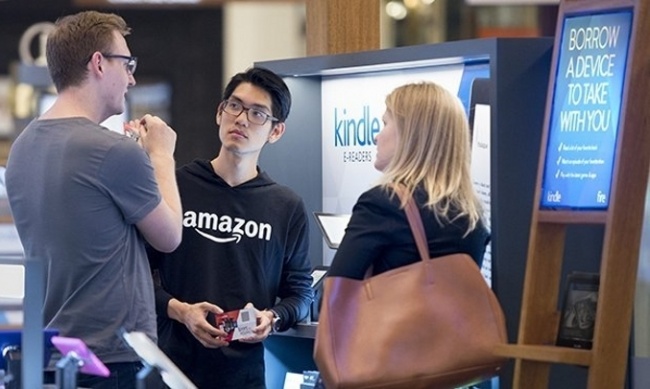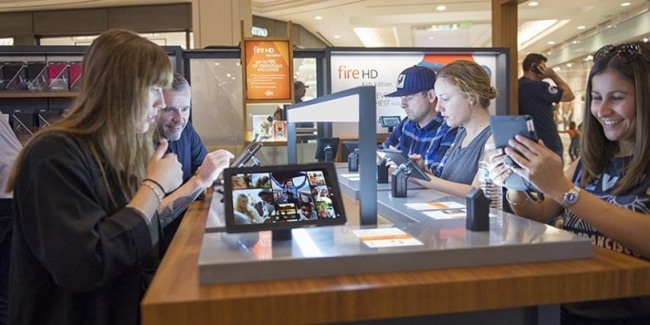The 300-500 square foot sales centers are larger than a Sunglass Hut but far smaller than a standard permanent retail space, and considerably smaller than the new Amazon Books retail locations being piloted in Seattle, Chicago and elsewhere. According to Business Insider, the pop-up stores are a project of Amazon’s Devices and Services group, not the division that is leading the bookstore initiative.
So, as one must always ask with all things Amazon, what’s the deal?
Occam’s Sledgehammer. Sometimes the simplest explanation is the best. Amazon is relentless in its quest to sell everyone everything everywhere all the time. History has shown that they will spend sloppy amounts of money to win scraps of market share that almost any other business would consider not worth the trouble.And thanks to their burgeoning cloud-computing business, money is not the problem. The company is awash with cash that they need to spend lest they violate Lord Bezos’ most sacred tenet: reinvest forever, profit never.
Setting up mall kiosks to showcase new gadgets has another upside. Amazon has gotten the cold shoulder at retail outlets like Target and Walmart, who are understandably reluctant to give the scorpion a lift across the river, so they need to blaze their own trail to market.
Pop-up stores are a lightweight alternative to hefty lease and staffing commitments, and an easy way to reach shoppers in the real world. Opening 21 or hundreds of pop-up locations is a typically brute-force solution to the immediate problem. Mission accomplished.
More Markets, More Data. A complementary explanation for the stores is that they are part of Amazon’s massive data-gathering operation, and its ongoing project to reconcile users’ online profiles, where every move consumers make can be and is tracked, and their real-world shopping habits, where they remain largely anonymous until they swipe their credit cards to complete the transaction.I have propounded this theory elsewhere and remain convinced that this is one big motive for Amazon’s otherwise-counterintuitive strategy of deciding to go for a swim in the brick-and-mortar pool after they have already drained out most of the water.
But if that were a major motivation for the pop-up stores, you’d think they’d be better coordinated with the chain of command that’s behind the bookstores. Instead, it seems like an independent project within the company, driven by the group specifically responsible for selling Kindles, Fires and Echos.
A Prisoner of Their Own Device? It’s not like devices are a moneymaker for Amazon in and of themselves. But they are the surest way to get Amazon-sourced products, particularly ebooks, into the hands of consumers without having to cut Apple and Google into the action through transaction fees.
This last bit is probably concerning to the company because app-based general purpose devices have largely replaced dedicated ebook readers like the Kindle as the main way people consume digital content these days. A recent report from Pew Research shows that among the 25-30% of readers who read books and comics digitally, most now prefer multifunction tablets like Apple’s iPad or Samsung’s Galaxy, or even cellphones, to dedicated ebook readers. (see “Reading Between the Lines of Pew’s 2016 Reader Survey – Favorable Trends for Comics”).
Placing the devices in malls, as tempting impulse purchases and last-minute gifts, may help pry that pipeline open a little bit wider.
Coming Soon to a Mall Near You? The Business Insider piece quotes an unnamed source that Amazon will have “up to 100 pop-up stores” in malls, with “dozens” slated to open in the next year. That’s a pretty robust effort, but if the goal is to sell consumers something that will end up selling them more things, it’s almost certain to be worth it.
And even if it isn’t, Amazon is more comfortable taking the risk than just about anyone else.











